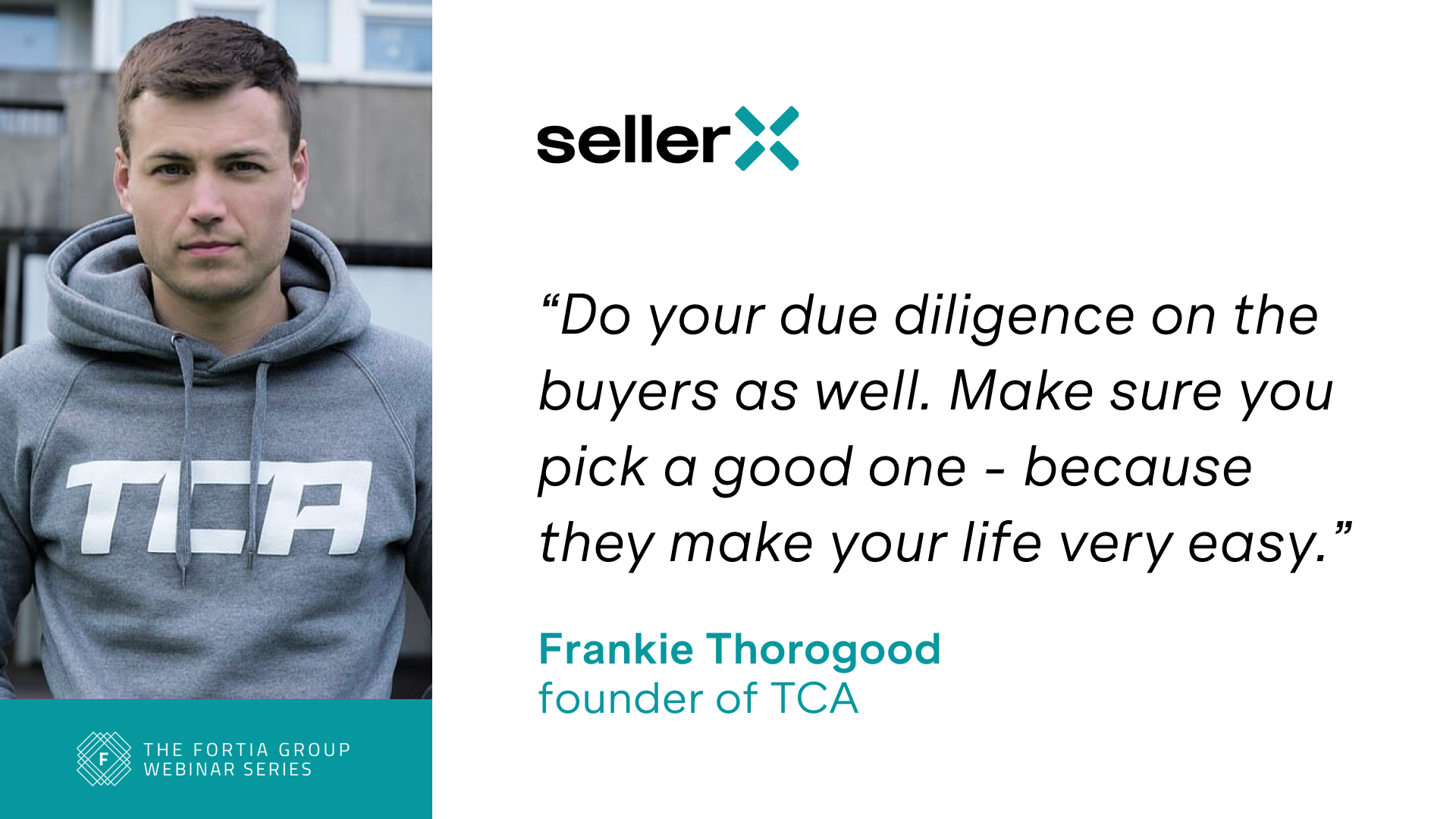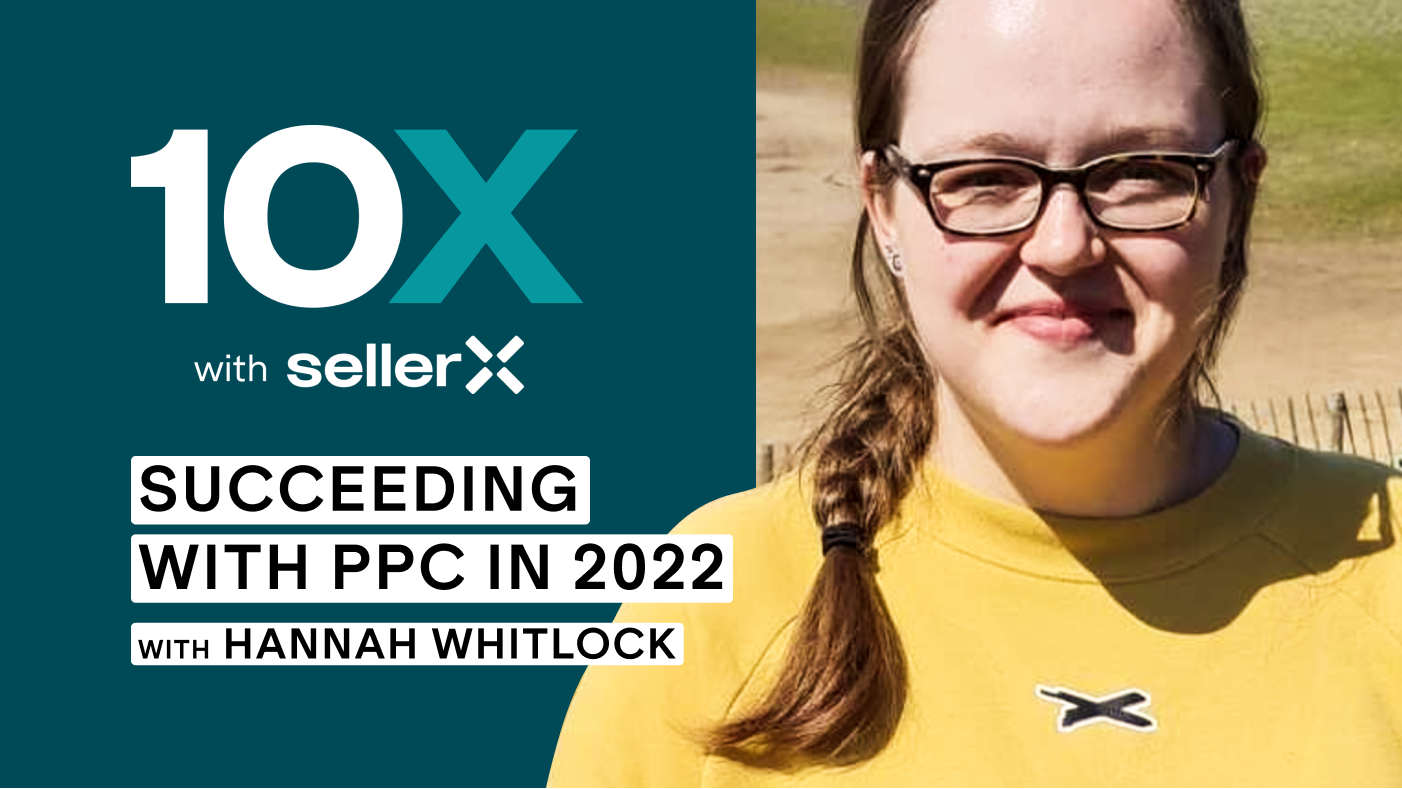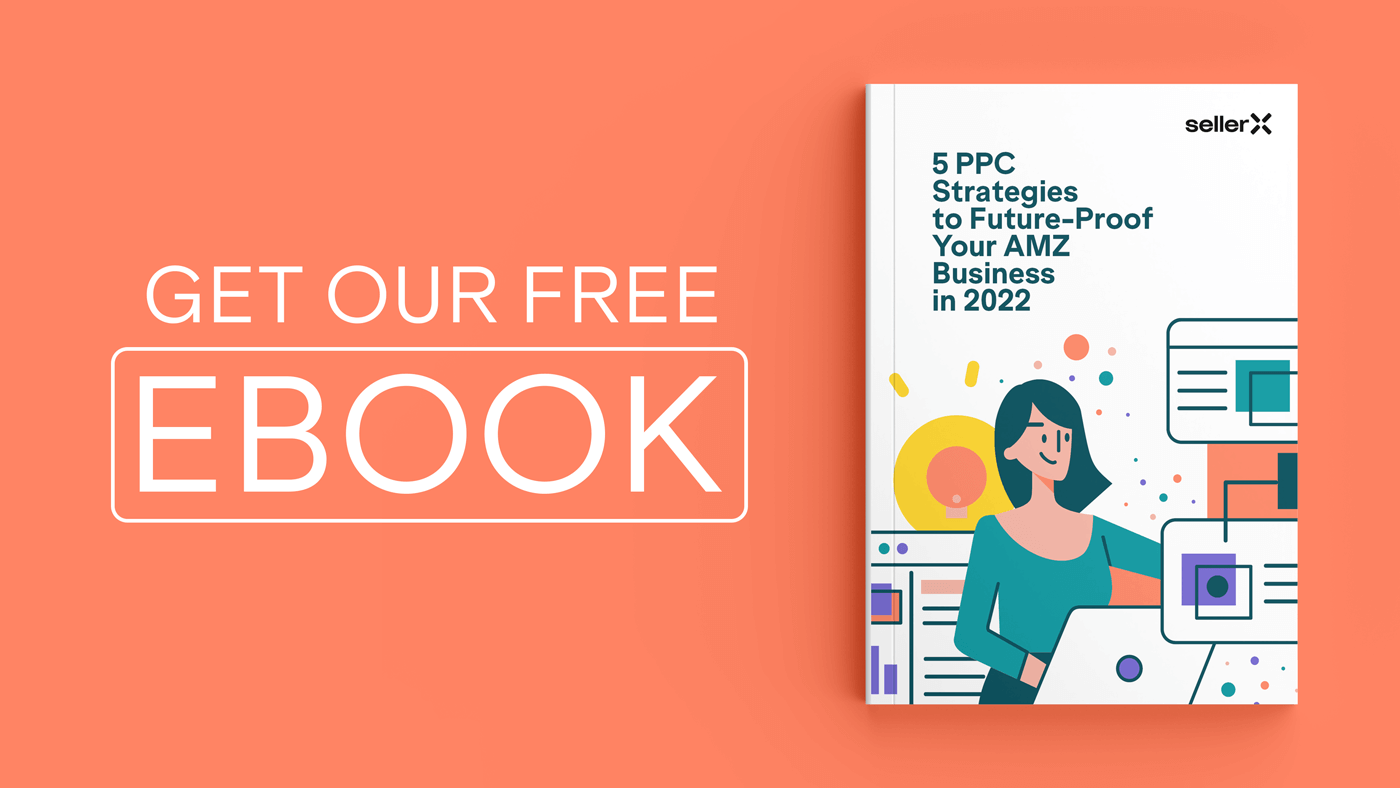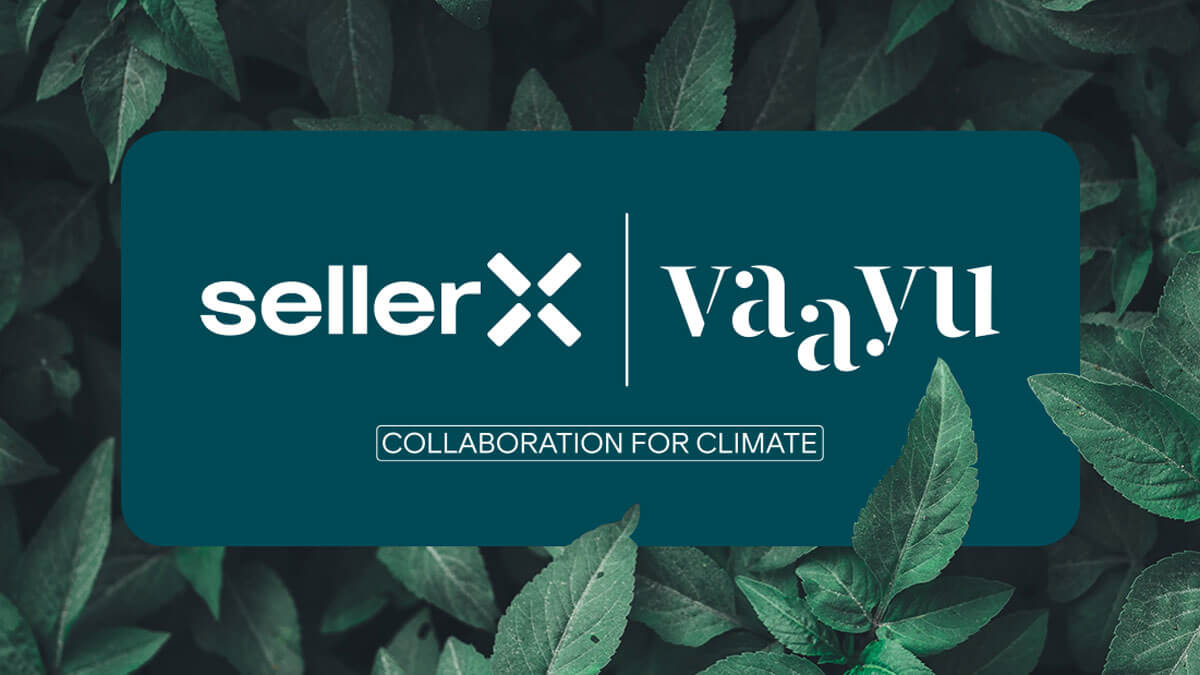Frankie Thorogood, founder of TCA, talks about why he sold his business in 2021 – and what’s happened since then
Frankie started his business with about $100 in 2012. By 2021, TCA had become a business with $6-10M yearly revenue, and Frankie decided to look for an acquirer. After receiving letters of intent from multiple aggregators, he chose SellerX to drive TCA forward, giving Frankie the space to explore his creative passions.
Frankie shares about his journey towards and beyond a sale on The Fortia Group Webinar Series. Here’s what he talks about:
- His exit process and deal terms
- What he would have done differently to increase TCA’s valuation
- TCA’s 43% YoY revenue growth
- Advice for sellers who want exits
Jump to
00:00 Intro to TCA
00:55 High SKU counts
02:00 The psychology of choice
03:00 Calculating margins
04:15 Increasing brand value
05:40 YoY growth since acquisition
05:50 Expansion into Italy
06:05 SellerX’s resources
06:50 Connecting with buyers
07:50 Doing due diligence on aggregators
Frankie:
Hi, everybody. Hello to the future millionaires out there listening. Well done for joining us. So I started the sportswear brand called TCA in 2012. So very, very early days, earlier than probably everybody else on the call.
Frankie:
And TCA was performance sportswear, is performance sportswear. So we worked with professional athletes and tried to create the highest quality performance products that we could. And that was our USP was that they were athlete approved, and grew the business for quite a long time before exiting.
Frankie:
Emma. You’re mute, I think.
Emmett :
Apologies, apologies. I’ve got to stay on my toes for 10 interviews. I mean, you had an unusual high amount of SKUs. Generally the buyers look for a low SKU count, but it’s great to see a firm like yours with SKUs in the thousands, get a great deal done. Could you give some context and color to that please?
Frankie:
It was something that I obviously only discovered in the process was that people considered us to have a large number of SKUs. And I think that there are two things I took from it was number one was, I understand why people don’t want a business with too many SKUs because it is complex and it does create more work and it diffuses your focus across different products.
Frankie:
But the other side of the coin is that it allowed us to grow a much bigger business than we otherwise would have by. And the reason why there were so many SKUs is basically because they’re all variations. So because it’s apparel, there’s different colors and different sizes, and that’s what made up the bulk of the SKUs. I think in terms of like a parent product is an individual pair of shorts or a t-shirt. There wasn’t that many, I don’t know how many it was in the end, maybe a hundred or something.
Frankie:
But the variations was a huge USP for us actually. Customers like to see variations and there’s a lot of data to show and this not just from our business, but from other bigger and more traditional retailers as well, is that when customers can see choice, they buy the same things more often, even if it’s not the extra choices that you’re offering them. So people like to see choice, they’re drawn in by choice. They like to see options and colors. So I think it really helped us.
Emmett :
Good to hear, good to hear. So, if we move to the next slide. I think you’re the fourth speaker, four in a row has talked about margin again. I’m assuming you’re… net margins. This is a massive takeaway from this webinar and something we’ll discuss with the panelists after the seller interviews.
Emmett :
But again, on your margin, looking back, what would you have done differently, Frankie? Where were you at exit? You know, would you have tried to plan the trajectory of margin differently?
Frankie:
Well, the way I started the business was I literally couldn’t calculate a margin until probably, you know what, I probably still can’t. I worked it out. Like I buy something for £2. I sell it for £12. All my costs come out, I make £4. If I sell a hundred of them, I make £400 pounds, blah, blah, blah.
Frankie:
You know, that’s how I did it. I did it pounds and pence, which in some ways seems more sensible because at the end of the day, cash is reality, like they say. But it’s not how everybody works, and there is obviously downside to that as well, because if you don’t control the other things, you can end up working for very little money.
Frankie:
I learned that lesson near the end and the good news was near the end is that we did have good margins, but they weren’t as good as they could have been for sure. And if I’d known it earlier, then obviously I would’ve built the business a bit like, I think it’s Anthony was saying earlier. Don’t kind of dilute your margin with poor margin products and just try to expand the high margin products.
Frankie:
So it completely changed my way of thinking. So if people are going to exit in the next six to 12 or 18 months, that’s something they should definitely start thinking about now is protecting that margin.
Emmett :
Yeah. Agreed. Specific examples on how you’d increase brand value if you were to go back and do it again.
Frankie:
Well, again, I think it’s Anthony. I hope I’m not getting his name wrong, but he was talking about brand. Ashley, I knew it was, sorry. He’s spot on, like the word brand is just being thrown around from pillar to post and has basically become meaningless.
Frankie:
A brand is an intangible asset. Coca-Cola is a brand. If Coca-Cola lost the recipe tomorrow, the company would survive because it’s all, the value’s in the brand. It’s an intangible thing. Whereas if everybody woke up tomorrow and forgot what Coca-Cola is, the company will be worthless.
Frankie:
So it’s not about the products, it’s about people’s perceptions. And that’s why it’s such a sticky issue to get your head around. But the brand is the perception of the customers. I think Bezos says, it’s what people say about you when you’re not in the room. It’s indicators of a brand when those are things you’re ultimately going to be measuring when you try and increase that value.
Frankie:
So repeat purchase rate was one thing that we had a huge advantage that proved our brand value. Our repeat purchase rate was 25%, which I think is extremely high. The other indicators you’d have is sort of like Google searches, social media following, email database, and so on.
Emmett :
Okay. Excellent. Let’s move to performance since acquisition. I assume you’re delighted with this performance. 43% year on year into 2022.
Frankie:
Well, I didn’t think they were going to do better than me, I have to say, but seems like they got some good people over there.
Emmett :
They clearly do. They clearly do. Why is Italy going so well?
Frankie:
Well, I don’t know what they’re doing that’s so great. But I do know that when we handed over the business, Italy was very, had not been given the attention it deserved. So, sounds like a simple thing, but highlight opportunities and put your resources behind them.
Frankie:
And SellerX obviously have, they’re bringing a whole lot of resources to the table that we didn’t have within the business. And I think it can be as simple as that is, we maybe knew in the back of our minds Italy was an opportunity, but we didn’t have the time or the resources to go after it.
Frankie:
Now, since we handed the business over, we told them that and they’ve just gone and put some rocket fuel behind it and they start to see the results and I think they’re even surpassing what they thought could be done.
Emmett :
Good, good. And Daniel from SellerX will be on the panel later. We can discuss performance. Final question for you, Frankie, is how would you, now having done an exit, how would you go about finding out about valuation calculations if you were to do it again?
Frankie:
Well, I think that the people who are giving out the valuations, i.e. the aggregators or the acquirers or the buyers, are very accessible and you can just come onto a webinar like today and listen to them and ask them. And I did that when we were exiting, but the industry was very much more immature at the time.
Frankie:
So I had to work quite hard to search out buyers and people who had done deals. And that’s what I use as my benchmark for valuations. But these days, I don’t think it’s that hard to find the data because everybody’s hunting for the deals.
Emmett :
Yeah, and of course, to give a plug for Fortia, we can help entrepreneurs think about valuation as well.
Frankie:
Yeah, and I would say as well, it’s not on here, but choosing who you accept an LOI from should be a tip here. There are aggregators out there that want to close deals. SellerX is one of them. They want to close deals. They don’t want to mess sellers around. So, do your due diligence on the buyers as well. Make sure you pick a good one because they make your life very easy.
Emmett :
Yeah. It’s a good point. In as much as the buyers are interviewing the sellers, it’s a two way process. The sellers should be interviewing the buyers. Totally agree with that. Frankie, great to see you again. Thanks for your time.
Frankie:
You’re welcome.
Emmett :
Have a nice evening.



